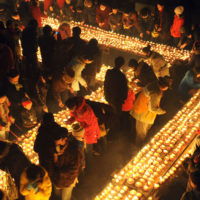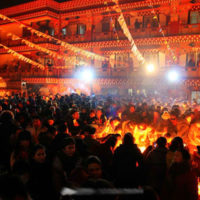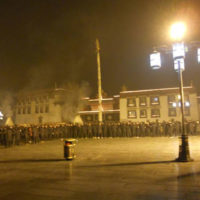
Tibetans in Dartsedo (Kangding) in Kardze (Ganzi) marking the ‘Festival of Lights’, Lama Tsongkhapa Day, on December 12.
Despite intense security with massed ranks of armed paramilitary forces, Tibetans gathered in large numbers last week across Tibet to mark an important Buddhist festival, Ganden Ngachoe, which marks the death anniversary of a prominent Tibetan Buddhist Master Tsongkhapa, the 14th-century founder of Tibet’s largest Buddhist school, the Gelug. The Dalai Lamas belong to the Gelug school. This festival has been observed in Lhasa over the past few years and can be described as a ‘Festival of Light’ as lighting of butter-lamps is an integral part of its observance.
The gatherings for the festival, including at monasteries in eastern Tibet that have been subject to heavy repression, are consistent with a pattern of large numbers of Tibetans marking prayer festivals at religious sites over the last few years despite an intimidating security presence and increasingly pervasive ‘grass roots’ restrictions and surveillance. This trend, demonstrating a spirit of strong resilience and determination to express Tibetan religious identity, is documented in these images of Tibetans gathering on the evening of the Ganden Ngachoe, which fell this year on December 12.
Click an image to begin slideshow
- Tibetans in Dartsedo (Kangding) in Kardze (Ganzi) marking the ‘Festival of Lights’, Lama Tsongkhapa Day, on December 12.
- Tibetans in Dartsedo (Kangding) in Kardze (Ganzi) marking the ‘Festival of Lights’, Lama Tsongkhapa Day, on December 12.
- Tibetans in Dartsedo (Kangding) in Kardze (Ganzi) marking the ‘Festival of Lights’, Lama Tsongkhapa Day, on December 12.
This footage depicts the scene on December 12 (2017) in Lhasa; prayers can be heard from Tibetans circumambulating the temple.
The festival is marked in Gelug monasteries across Tibet and this year in Kham and Amdo at the same time as in central Tibet. Large numbers of devotees also gathered at monasteries in eastern and north-eastern Tibet, including at Rongwo monastery in Rebkong (Chinese: Tongren) in Qinghai and at Labrang Tashikyil (Chinese: Xiahe) in Gansu. In Kham, there was a large gathering of Tibetans in Dartsedo (Chinese: Kangding) and in Kardze (Chinese: Ganzi) county town in Sichuan. Chinese armed police kept close watch but did not prevent any of the gatherings, Tibetan sources said.
Many Tibetans refrained from consuming meat during the prayer festival, and others freed animals from slaughterhouses to mark Ganden Ngachoe. A Tibetan source told Radio Free Asia’s Tibetan service that at Rongwo in Rebkong, large numbers of devotees gathered to make offerings and circumambulate the temples. “As evening approached, those taking part offered not only butter lamps inside and outside the temples, but also electric lights inside the prayer halls, a practice that is becoming more and more popular in observance of Tsongkhapa’s day,” he said. (Radio Free Asia Tibetan service, December 12, 2017).[1]
Click an image to begin slideshow
- Fire extinguishers and fire vehicles have also been a feature since the self -immolations began in Tibet. These images depict the prayer festival in 2016, showing troops with riot shields and the incense burners in the Jokhang Square.
- Fire extinguishers and fire vehicles have also been a feature since the self -immolations began in Tibet. These images depict the prayer festival in 2016, showing troops with riot shields and the incense burners in the Jokhang Square.
- Fire extinguishers and fire vehicles have also been a feature since the self -immolations began in Tibet. These images depict the prayer festival in 2016, showing troops with riot shields and the incense burners in the Jokhang Square.
- Fire extinguishers and fire vehicles have also been a feature since the self -immolations began in Tibet. These images depict the prayer festival in 2016, showing troops with riot shields and the incense burners in the Jokhang Square.
- Fire extinguishers and fire vehicles have also been a feature since the self -immolations began in Tibet. These images depict the prayer festival in 2016, showing troops with riot shields and the incense burners in the Jokhang Square.
- Fire extinguishers and fire vehicles have also been a feature since the self -immolations began in Tibet. These images depict the prayer festival in 2016, showing troops with riot shields and the incense burners in the Jokhang Square.
- Fire extinguishers and fire vehicles have also been a feature since the self -immolations began in Tibet. These images depict the prayer festival in 2016, showing troops with riot shields and the incense burners in the Jokhang Square.
- Fire extinguishers and fire vehicles have also been a feature since the self -immolations began in Tibet. These images depict the prayer festival in 2016, showing troops with riot shields and the incense burners in the Jokhang Square.
- Fire extinguishers and fire vehicles have also been a feature since the self -immolations began in Tibet. These images depict the prayer festival in 2016, showing troops with riot shields and the incense burners in the Jokhang Square.
- Security police in 2015 at the Ganden Ngachoe ‘Festival of Lights’ in Lhasa.
- Security police in 2015 at the Ganden Ngachoe ‘Festival of Lights’ in Lhasa.
In Lhasa, devotees visited the Jokhang Temple in tightly packed lines on Tuesday (December 12) to offer lamps. Videos and still images show massed troops in ranks in the square and amidst the crowds.
A Tibetan in exile from Amdo said: “Inside Tibet, it is regarded as very auspicious and has a deep meaning to participate in this festival in Lhasa, so a lot of people travel there on pilgrimage. His Holiness the Dalai Lama is regarded by Tibetans as the living and best student of Tsongkhapa.”
Last year, and in 2013 and 2014, striking images emerged from Tibet of Tibetans gathering in the thousands at monasteries despite the deployment of large numbers of uniformed and plainclothes paramilitary police, to mark the Monlam Chenmo, or Great Prayer Festival, which usually falls in February. Last year, Tibetans gathered even at monasteries where levels of repression have been high, amid both an armed and plain clothes police presence, for instance at Kirti in Ngaba (Chinese: Aba), Sichuan.[2]

These stunning images of Labrang Tashikyil (Chinese: Laboleng in Xiahe) monastery in Gansu at the Monlam Chenmo depict thousands of pilgrims gathering to mark the festival on February 22.
In 2013, striking images had emerged of thousands of Tibetans gathered in the last few days of Tibetan New Year (Losar) for significant religious ceremonies in eastern Tibet, despite being forced to confront massed ranks of armed troops. Vivid images disseminated on social media show higher numbers of Tibetans than usual gathering to pray at major monasteries – Labrang and Kumbum – during the Monlam prayer festival as troops stood guard or encircle the pilgrims. The new pictures emerged days in the tense buildup to March 10, the sensitive anniversary of Tibet’s national uprising and the anniversary of an unprecedented wave of mostly peaceful protests that swept across the Tibetan plateau in 2008.[3]

Tibetans surrounded by police as they enter Kumbum monastery.
A former monk from Labrang monastery who now lives in exile told ICT: “What is most striking about these images is both the number of pilgrims, and the strong presence of Chinese soldiers. Normally you would not see such a strong military presence at a prayer ceremony. This shows the fears of the authorities about the self-immolations and protests. The number of pilgrims shows how determined people are to pray and make offerings at such a dangerous time in Tibet.”
This festival is also observed in Tibetan Buddhist monasteries in India and also in Tibetan homes across the diaspora.
Footnotes:
[1] http://www.rfa.org/english/news/tibet/gathering-12122017170322.html
[2] See slide show at International Campaign for Tibet report, Thousands of Tibetans gather across Tibet to mark prayer festival; lockdown of TAR to foreign tourists, February 25, 2016, https://www.https://savetibet.org/thousands-of-tibetans-gather-across-tibet-to-mark-prayer-festival-lockdown-of-tar-to-foreign-tourists/
[3] International Campaign for Tibet report, ‘Thousands of Tibetan pilgrims face troops at religious ceremonies in eastern Tibet’, March 13, 2013, https://www.https://savetibet.org/thousands-of-tibetan-pilgrims-face-troops-at-religious-ceremonies-in-eastern-tibet/















